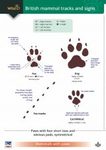About this book
This report continues our monographic analysis of mammalian diversity and Matses ethnomammalogy in the Yavari-Ucayali interfluvial region of northeastern Peru. Based primarily on specimens collected in the region from 1926 to 2003, interviews with Matses hunters, and published sight surveys of large mammals, we document the local occurrence of 33 species of xenarthrans, carnivores, perissodactyls, artiodactyls (including cetaceans), and sirenians. All of the species in these groups, with the exception of the Amazonian manatee (Trichechus inunguis), are recognized and named by the Matses, from whom we recorded extensive accounts of mammalian natural history.
The local xenarthran fauna consists of nine species (Cabassous unicinctus, Priodontes maximus, Dasypus novemcinctus, D. pastasae, Bradypus variegatus, Choloepus hoffmanni, Cyclopes didactylus, Myrmecophaga tridactyla, Tamandua tetradactyla), all of which are represented by examined specimens. Only two xenarthrans (D. pastasae and C. hoffmanni) are primary game species for the Matses, who are familiar with many aspects of their biology that were previously unrecorded in the scientific literature. However, Matses interviews also provide important new information about the behavior of D. novemcinctus (a secondary game species) and M. tridactyla, neither of which has previously been studied in rainforested environments.
The local carnivore fauna consists of 16 species (Atelocynus microtis, Speothos venaticus, Leopardus pardalis, L. wiedii, Panthera onca, Puma concolor, Pu. yagouaroundi, Eira barbara, Galictis vittata, Mustela africana, Lontra longicaudis, Pteronura brasiliensis, Bassaricyon alleni, Nasua nasua, Potos flavus, Procyon cancrivorus), most of which are represented by examined specimens; six species without preserved voucher material are known from camera-trap photographs and/or unambiguous sightings by Matses hunters and field biologists. Although the coati (N. nasua) is the only carnivore occasionally hunted by the Matses for food, Matses interviews are richly informative about the natural history of other species, notably including S. venaticus, Leopardus spp., Pa. onca, Puma spp., and E. barbara.
All of the local ungulates (Tapirus terrestris, Pecari tajacu, Tayassu pecari, Mazama americana, M. nemorivaga) are hunted by the Matses for food, and the hunters we interviewed are correspondingly well informed about the natural history of most of these species, with the exception of the seldom-encountered gray brocket (M. nemorivaga). Both species of local cetaceans (Inia geoffroyi, Sotalia fluviatilis) are familiar to the Matses, although neither is eaten.
The xenarthrans, carnivores, ungulates, and aquatic mammals that inhabit the Yavari-Ucayali interfluve are all widespread species, so this component of the regional fauna, as currently understood, is not biogeographically distinctive, nor is it extraordinarily diverse (by western Amazonian standards). Although we discuss several noteworthy taxonomic and nomenclatural issues relevant to these taxa, the principal contribution of this report consists in the natural history information compiled from our Matses informants and the resulting overview of local community structure as defined by diurnal activity, locomotion, social behavior, and trophic relationships.
Customer Reviews






























![How to Find and Identify Mammals [Revised Edition]](http://mediacdn.nhbs.com/jackets/jackets_resizer_medium/21/210208.jpg?height=150&width=106)













